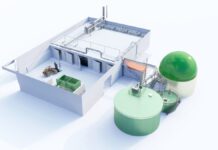Biogas generated from anaerobic digestion (AD) contains a mixture of compounds including water vapour. This is not always considered by those burning biogas in a combine heat and power (CHP) facility.
If water enters a CHP engine it can decrease its efficiency and lead to corrosion, resulting in reduced biogas yields and engine damage. CHP engines are one of the most expensive pieces of equipment to replace on an AD plant, so it makes sense to look after them.
Additionally, an inefficient CHP engine will result in lower electrical output and higher capex. Removing water from biogas also prevents corrosion of other pipework and components and removes a proportion of water-soluble gases such as hydrogen sulphide, ammonia and siloxanes.
The HRS Biogas Dehumidification System (BDS) is specifically designed to remove water with the minimum use of additional energy. Rather than heating the biogas to dry it, the BDS uses condensation to remove water from the gas.
By reducing biogas temperatures from ~40oC to ~6oC, more than 90% of the water volume is condensed from the gas. A chiller system supplies coolant which is transferred to heat exchangers: as the biogas cools, the water condenses from the gas, leaving a clean and dry biogas ideal for use in CHP engines. Heat recovery uses the cold biogas is used to pre-cool any incoming biogas before entering the CHP, reducing the cooling load and recovering as much as 20% of the energy needed for the process.







